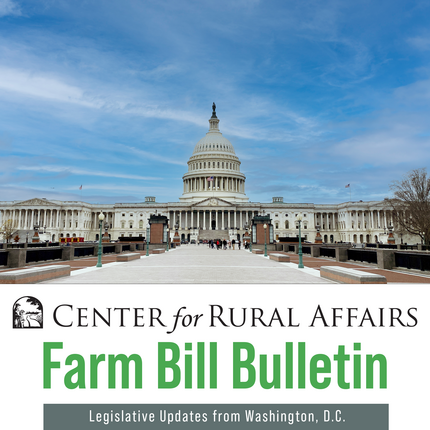By Kate Hansen, former staff member
This blog is part of our “Farm Bill Bulletin” series, which provides intermittent updates on the development and status of our nation’s next farm bill.
This month, members of Congress returned to Washington D.C. to resume business after the August recess. Their progress on the farm bill has been limited as a key date looms.
Our current farm bill—passed in 2018—will expire on Sept. 30, at which point important food, agriculture, and rural programs will be in limbo. Some programs will no longer be legally authorized to run, while others will be required to operate according to antiquated “permanent law” as far back as the 1938 and 1949 farm bills.
One requirement that will be triggered in 2024 is for the U.S. Department of Agriculture to maintain dairy prices at a certain level, commonly referred to as the “dairy cliff.” Earlier this month, economists at the University of Minnesota estimated this scenario would cause the retail price of milk to more than double. Other commodities, like corn and wheat, would follow.
To avoid expiration, members of Congress can take one of two actions—pass a new farm bill or pass an extension of the current one.
Unfortunately, it is not feasible for a new farm bill to be approved before Sept. 30, due to the extent of negotiations required to reach an agreement. Passing a new farm bill would first require the Senate and House to approve independent versions of the bill before coming together to agree on a final version.
It also appears unlikely that Congress will agree to an extension by the deadline. It is more likely an extension will be passed by the end of year or early next year—before program changes could impact the 2024 crop year.
The stall in farm bill progress is largely attributed to another important Sept. 30 deadline—funding the government. You may have learned in civics class that Congress “controls the purse strings.” Each year, it is responsible for allocating funding for the next fiscal year. If Congress fails to do so by the deadline, there will be a government shutdown and federal agencies must cease operations, with some exceptions.
This year, political tension is high between Republican caucuses in the House, and both major political parties in the full Congress. We will likely see leaders try to pass a continuing resolution before Sept. 30—a temporary spending bill that would extend the timeframe to negotiate without shutting down the government. It remains to be seen whether or not they will be successful.
If there is anything lawmakers agree on, it’s that the timelines for appropriations and the farm bill are uncertain. A silver lining is that the longer negotiations take, the longer our window of opportunity is to encourage them to support key initiatives.





